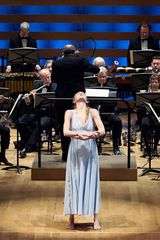|
Back
Cell phones welcome! Toronto
Koerner Hall
02/11/2018 -
José Evangelista: Symphonie minute
Eugene Astapov: Hear My Voice
Matthew Ricketts: Lilt*
Unsuk Chin: Mannequin - Tableaux Vivants for Orchestra
Tan Dun: Passacaglia: Secret of Wind and Birds
Esprit Orchestra, Alex Pauk (conductor)
Jennifer Nichols* (choreographer and dancer)

J. Nichols (© Malcolm Cook)
Just for something different, here was a concert where cell phones were welcome. For his Passacaglia: Secret of Wind and Birds (composed in 2015) Tan Dun first composed bird sounds using six traditional Chinese instruments (guzheng, suona, erhu, pipa, dizi, and sheng). The 54-second piece was then made available for downloading, which those attending the concert were asked to do. Just before starting the 12-minutes work, conductor Alex Pauk divided the hall into four quadrants and gave specific instructions to each group for “playing” the birdsong, and this was how the piece began. The impression was that of a flock of chattering birds swooping around the auditorium. The orchestra’s part opens quietly with the harp imitating birdsong, then the trombone playing glissando passages, joined by the strings also glissando. Then the passacaglia theme is announced and quite a grand passage it is - something that Anton Bruckner would have liked. It evolves through nine repetitions. At one point the orchestra members chant quietly, at another their cell phones play the birdsong. The work builds to an excited climax with a hint of anguish in it. An exuberant finish to a solidly satisfying concert.
The concert opened with José Evangelista’s Symphonie minute of 1994, a playful seven-minute symphony dedicated to the composer’s children. It has the requisite four movements (Envol - Mélopée - Combat - Presto chromatique) which contain quite the concentration of musical ideas. I felt the Mélopée movement could have benefited from further development, but then it wouldn’t have been so minute. This is the fifth time Esprit has performed it and I can understand why - it is a delight.
Eugene Astapov’s Hear My Voice was premiered by Esprit last April and a second hearing seems well worthwhile. The voice referred to is that of Alexander Graham Bell whose experiment in 1884 with recording his voice in wax on cardboard could not be retrieved until 2013 thanks to efforts by the Smithsonian Institution and scientists in California. The music (conducted by the composer) frequently forms a sonic nimbus around the various recordings of Bell’s voice - one phrase is “Hear my voice”. It ends appropriately with a bell-like sound from a chime. The piece for about 20 players is also scheduled by the Vancouver Symphony Orchestra.
The evening’s world premiere was Matthew Rickett’s Lilt, a dance piece for a solo performer, in this case Jennifer Nichols, best described as a one-woman hive of activity. Her dance style exemplifies the contemporary approach with extension contrasted with contraction - in her own words “a physical vocabulary which suggests states of spinning, reaching, and of settling”. This engaging work represents a very successful collaboration between composer and choreographer. The 45 or so orchestral players were relegated to the back of the platform.
The biggest work on the program was Unsuk Chin’s Mannequin (2015), a feverish tone poem for “imaginary choreography” based on E.T.A. Hoffmann’s hallucinogenic novella The Sandman. The 30-minute piece has four discrete and very distinctive movements: Music Box - Fever Dream; Sandman and child; Dance of the Clockwork Girl; and Stolen Eyes. The composer calls the sections tableaux vivants and very vivant they are. The Clockwork Girl is, of course, Olympia, the character in one of Offenbach’s Tales. The program notes for the work are detailed and dense. I wouldn’t be surprised if a choreographer somewhere might be inspired by this vivid work.
About 65 players were involved in the Unsuk Chin and Tan Dun works. All five works turned out to be of absorbing interest.
Michael Johnson
|